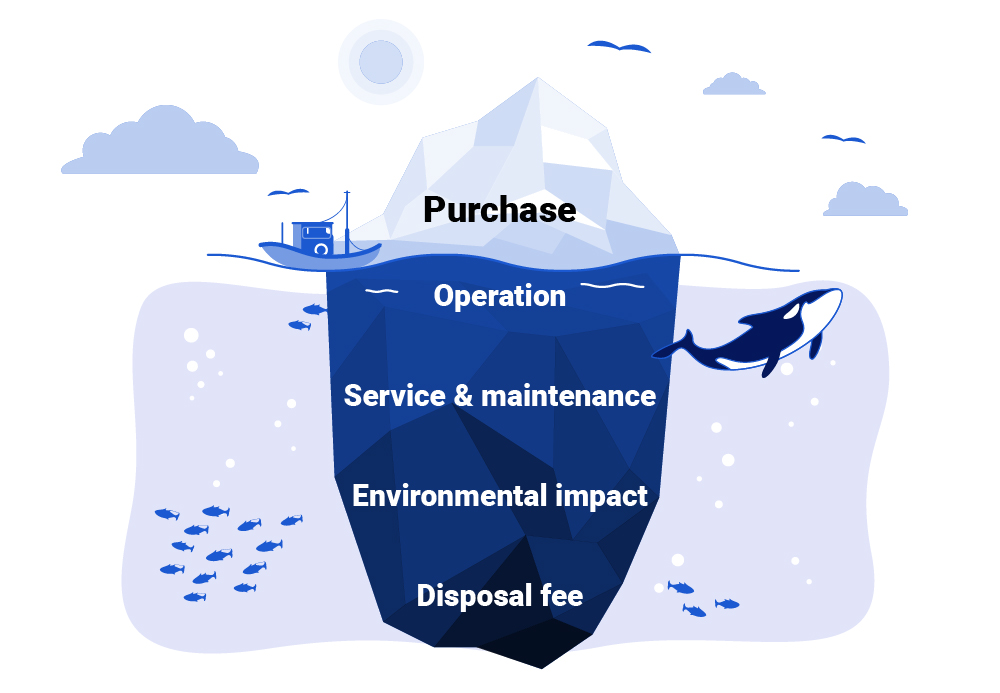Life cycle costing (LCC) is an essential financial tool that allows businesses to calculate the total costs associated with the acquisition, operation, maintenance, and disposal of assets over their entire life span. This comprehensive approach to costing offers a clearer picture of long-term financial implications, enabling smarter investment decisions and effective long-term planning. By understanding the full scope of costs, businesses can avoid short-sighted purchases that may be cheaper upfront but more expensive over time. In this article, we delve into what life cycle costing is, its importance for businesses, and how it can be implemented to enhance financial strategies.
Key Takeaways
- Life cycle costing helps businesses understand the total cost of ownership, beyond initial purchase prices, for more informed investment decisions.
- Implementing life cycle costing promotes long-term planning and budgeting, allowing for more reliable financial forecasting.
- Adopting life cycle costing can uncover hidden or recurring costs that significantly impact the overall cost efficiency of business decisions.
- Life cycle costing is a tool for strategic asset management, aiding in the comparison of long-term costs and benefits of different investments.
- Through practical examples and a step-by-step guide, businesses can learn how to effectively apply life cycle costing to their strategic planning.
Cracking the Code on Life Cycle Costing
What Exactly Is Life Cycle Costing?
Imagine you’re eyeing that shiny new piece of equipment for your business. You’re not just looking at the price tag, right? You’re considering all the costs that’ll come up while it’s chugging away for you – from the day it lands in your workspace to the day you wave it goodbye. That’s life cycle costing (LCC) in a nutshell. It’s about being smart with your money by accounting for every penny it’ll cost over its lifetime.
So, why should you care? Well, life cycle costing helps you avoid nasty surprises down the road. It’s like having a financial crystal ball, giving you a heads-up on future expenses. Here’s a quick rundown of what you’ll be looking at:
- Initial purchase price
- Installation costs
- Operating expenses
- Maintenance and repair
- Replacement parts
- Residual value at the end of life
- Disposal
By considering these factors, you’re not just spending money; you’re investing it wisely. LCC ensures you’re not blindsided by hidden costs and can plan your budget with your eyes wide open.
The Real-World Benefits of Adopting Life Cycle Costing
Imagine you’re at a crossroads, deciding between two assets for your business. One has a lower upfront cost, but what about the long haul? Life Cycle Costing (LCC) gives you the full picture, allowing you to weigh the total costs over an asset’s life. It’s like having a financial crystal ball, showing you not just the purchase price, but the sum of all future expenses.
- Better decision-making: With LCC, you’re not just saving pennies today, but potentially dollars tomorrow.
- Cost reduction: Identifying areas ripe for cost-cutting becomes clearer when you see the whole timeline.
- Profit maximization: For the long-term thinkers, LCC is a strategy that aligns with maximizing profits over time.
By adopting LCC, you’re not just buying an asset; you’re investing in the future of your business. It’s a shift from short-term gains to long-term success.
Remember, it’s not just about the sticker price. The real cost of ownership includes maintenance, operating costs, and those pesky recurring costs that can sneak up on you. LCC helps you to understand these cost consequences, ensuring that your business stays ahead of the curve.
Life Cycle Costing: A Tool for Smarter Purchasing Decisions
Imagine you’re eyeing that shiny new piece of equipment for your business. It’s tempting to just look at the sticker price and make a quick decision, right? But hold on a second. Life cycle costing is the process of estimating how much money you will spend on an asset over the course of its useful life, not just its upfront cost. It’s like looking beyond the tip of the iceberg to see what’s lurking beneath the surface.
By diving into the full cost spectrum, you’re not just spending money; you’re investing it wisely. Life cycle costing gives you a crystal-clear picture of the total investment involved, including those sneaky recurring costs that can pile up over time.
Here’s why it’s a game-changer for your purchasing decisions:
- It helps you avoid the trap of low upfront costs that can lead to higher long-term expenses.
- You’ll get a realistic estimation of the total cost of ownership, which is crucial for long-term planning.
- It empowers you to compare competing options on a deeper level, ensuring you choose the asset that truly offers the best value.
So, before you make that purchase, take a moment to consider the full life cycle cost. It could be the difference between a decision that looks good now and one that feels great for years to come.
The Financial Perks of Life Cycle Costing for Your Business
How Life Cycle Costing Fuels Long-Term Planning
Imagine you’re at the helm of your business, charting the course for the years ahead. Life cycle costing is your compass, guiding you through the financial seascape with a clear view of the costs that lie beneath the surface. By integrating life cycle costing into your long-term planning, you’re not just preparing for the initial costs; you’re bracing for the entire journey ahead.
- Initial Purchase: You’ll know exactly what you’re diving into upfront.
- Maintenance: Regular check-ups won’t catch you off guard.
- End of Life: When it’s time to say goodbye, you’ll be ready for the send-off.
With life cycle costing, you’re not just reacting to expenses as they arise; you’re anticipating them, allowing for a more strategic allocation of your budget over time. This proactive approach can be a game-changer for your business, ensuring that you’re not blindsided by hidden costs or unexpected financial storms.
Companies that embrace life cycle costing find themselves in a stronger position to maximize profits over the long term. They’re the ones who understand that the cheapest option at checkout can sometimes turn out to be the most expensive one down the line. So, when you’re weighing your options, remember that life cycle costing is about seeing the full picture, not just the price tag in front of you.
Setting a Reliable Budget with Life Cycle Costing
Imagine you’re setting up a budget for the next big project or purchase. You’ve got the initial price tag in hand, but is that the whole story? Life cycle costing peels back the layers of expenses that will crop up over time, giving you a clearer picture of what’s to come. It’s like having a financial crystal ball, ensuring you’re not blindsided by unexpected costs.
By integrating life cycle costing into your budgeting process, you’re not just accounting for the upfront costs; you’re preparing for maintenance, operation, and even disposal expenses. This holistic view allows you to allocate funds more accurately, avoiding the pitfalls of underestimating costs and overestimating profits, which can lead to serious repercussions.
With life cycle costing, you’re not playing a guessing game with your finances. You’re making informed decisions that will stand the test of time.
Here’s a quick rundown of how life cycle costing can transform your budgeting strategy:
- Identify all costs: From initial purchase to disposal
- Predict future expenses: Be ready for maintenance and upgrades
- Optimize pricing: Ensure your products or services are priced right
- Plan for the long haul: Allocate your budget to cover the product’s lifespan
Remember, life cycle costing isn’t just about counting pennies; it’s about understanding the full financial journey of your investments.
Life Cycle Costing: The Secret to Cost-Efficient Business Decisions

Imagine you’re at a crossroads with two products in hand. One’s cheaper upfront, but the other promises lower costs in the long run. Life cycle costing is your compass for navigating this decision, ensuring you don’t just save now, but you save big over time.
Here’s the deal: that low upfront cost can be a siren song, luring you into a cycle of high maintenance and operating expenses. But when you play the long game with life cycle costing, you’re looking at the full picture. You’re not just buying a product; you’re investing in its entire lifespan.
By comparing the total costs of ownership, life cycle costing empowers you to pick the option that’s truly cost-efficient, not just the one with the smallest price tag at checkout.
Let’s break it down with a simple example:
- Product A: Initial cost of $300, with $200 in maintenance over 5 years.
- Product B: Initial cost of $500, but only $50 in maintenance over the same period.
Without life cycle costing, you might jump at Product A. But add it up, and Product B is the real winner for your wallet. It’s all about seeing beyond the now and planning for the future. And that, my friend, is how you make decisions that keep your business lean and mean.
Life Cycle Costing Unveiled: Examples and Insights
A Practical Example of Life Cycle Costing in Action
Imagine you’re eyeing that shiny new piece of equipment for your production line. It’s got all the bells and whistles and, best of all, it’s got a price tag that seems too good to be true. But hold on a second, let’s put life cycle costing to work before you whip out the company credit card.
First, you’d tally up the initial purchase price, sure, but that’s just the start. You’d also need to consider the ongoing maintenance costs, energy usage, potential downtime, and even eventual disposal costs. To give you a clearer picture, let’s break it down in a simple table:
| Cost Type | Year 1 | Year 2 | Year 3 |
|---|---|---|---|
| Initial Purchase | $10,000 | $0 | $0 |
| Maintenance | $500 | $700 | $900 |
| Energy Usage | $250 | $300 | $350 |
| Downtime | $100 | $150 | $200 |
| Disposal | $0 | $0 | $500 |
By the end of Year 3, the total isn’t just the initial $10,000, but rather a more substantial $13,200. And that’s a conservative estimate!
This is the kind of insight life cycle costing brings to the table. It’s not just about the sticker price; it’s about the full financial journey of an asset. By considering all these factors, you’re not just spending money, you’re investing it wisely. And that’s how you make sure your business isn’t just surviving, but thriving.
Understanding the Impact of Recurring Costs Over Time
Let’s talk turkey about those pesky recurring costs. You know, the ones that seem small at first but can snowball into a financial avalanche over the lifespan of an asset. The real kicker is how these costs can stealthily chip away at your budget. Maintenance, repairs, and operational expenses might look manageable in the short term, but they can transform into the heavyweight champions of your total expenditure.
Consider this: a piece of equipment with a seductive low upfront cost might have you doing a victory dance at first. But fast forward a few years, and the tune changes as maintenance and operational costs start to pile up. Here’s a snapshot to give you a clearer picture:
| Year | Maintenance Costs | Operational Costs | Total Recurring Costs |
|---|---|---|---|
| 1 | $500 | $1,000 | $1,500 |
| 2 | $600 | $1,100 | $1,700 |
| 3 | $700 | $1,200 | $1,900 |
| 4 | $800 | $1,300 | $2,100 |
| 5 | $900 | $1,400 | $2,300 |
Remember, it’s not just about the initial price tag. It’s the long game that counts. Those recurring costs can add up to a sum that far exceeds the initial savings.
So, when you’re eyeing that shiny new asset, take a beat to think about the long haul. Will the recurring costs leave you with a case of buyer’s remorse? Or will you be patting yourself on the back for making a savvy decision that keeps paying off? Life cycle costing helps you see beyond the now and plan for a cost-effective future.
Why Initial Purchase Price Is Just the Tip of the Iceberg
Let’s face it, when you’re eyeing that shiny new piece of equipment, the sticker price can be pretty alluring. But hold up! That initial cost is just the beginning. Think of it as the first chapter in a much longer saga. You’ve got to factor in all the other expenses that’ll pop up over the asset’s lifetime. We’re talking maintenance, repairs, energy use, and even the eventual disposal costs.
Consider this: a piece of equipment with a purchase price of $10,000 might actually end up costing you $16,000 over its life. Check out this breakdown:
| Particulars | Value ($) |
|---|---|
| Purchase cost | 10,000 |
| Installation cost | 500 |
| Operating cost | 3,000 |
| Maintenance cost | 1,000 |
| Depreciation | 500 |
| Disposal value | -1,000 |
| Total Life Cycle Cost | 16,000 |
Remember, the true cost of ownership includes every penny you’ll spend from the moment you buy until you say goodbye.
By looking beyond the upfront price, you’re setting yourself up for a more accurate financial picture. And let’s be real, surprises are great at parties, but not so much in your budget.
Navigating the Nitty-Gritty of Life Cycle Costing

Is There a Magic Formula for Life Cycle Costing?
If you’re looking for a magic formula for life cycle costing, you might be a tad disappointed. Life cycle costing isn’t about pulling rabbits out of hats; it’s about a methodical approach to understanding the true costs of your business assets over their entire lifespan.
Think of it as a puzzle where each piece represents a different cost associated with your asset. You’ve got your initial purchase price, sure, but that’s just the beginning. Add to that the maintenance costs, operating expenses, and those sneaky recurring costs that can creep up on you. And let’s not forget about the potential residual value at the end of the asset’s life.
It’s all about piecing together the full picture of an asset’s cost, from cradle to grave, to make informed decisions that go beyond the price tag.
Here’s a simple breakdown to get you started:
- Initial Purchase Price: The upfront cost of acquiring the asset.
- Maintenance and Operating Costs: Regular expenses to keep the asset running.
- Recurring Costs: Periodic expenses that occur throughout the asset’s life.
- End of Life Residual Value: The estimated value of the asset when it’s time to say goodbye.
Remember, the goal is to aggregate all the costs associated with a particular asset for each year of its usable life and then add them all up. This gives you a more accurate picture of what that asset will really cost you over time.
Identifying Hidden Costs: A Life Cycle Cost Analysis
Ever felt like you got a great deal on something, only to find out later that the costs just kept piling up? That’s where life cycle cost analysis comes in handy. It’s like a financial detective, uncovering all those sneaky costs that aren’t obvious at first glance. You know, the ones that can turn a bargain into a budget-buster over time.
Imagine you’re eyeing that shiny new piece of equipment for your business. The price tag looks good, but what about the costs of installation, maintenance, or even disposal down the line? A life cycle cost analysis will lay it all out for you, so you’re not caught off guard. Here’s a quick rundown of what you might uncover:
- Initial purchase price
- Installation costs
- Operating expenses
- Maintenance and repair
- Downtime and loss of productivity
- End-of-life disposal or trade-in value
By identifying and considering these costs upfront, you’re setting yourself up for a more accurate picture of the Total Cost of Ownership (TCO). And that’s crucial for making smart, cost-effective decisions for your business.
So, when should you whip out this handy tool? Ideally, before you make a purchase. It’s all about getting the full story on what an asset will really cost you, not just today, but throughout its entire lifespan. That way, you can compare options not just by their sticker price, but by their true cost to your business.
Life Cycle Costing: Your Crystal Ball for Future Expenses
Imagine having a crystal ball that could reveal the true cost of your business decisions, not just today, but years down the line. Life Cycle Costing (LCC) is that crystal ball, giving you the power to see beyond the initial price tag. By considering all future expenses, you’re not just spending money; you’re investing it wisely.
With LCC, you’re not left in the dark guessing about future costs. Instead, you’re equipped with a method that takes into account the present value (PV) dollars, making future costs and benefits comparable today.
Here’s a simple breakdown of the LCC process:
- Tally up fixed costs, the predictable expenses that don’t fluctuate over time.
- Estimate variable costs, which can change based on usage, market conditions, and other factors.
- Use past data as a guide to refine your predictions and ensure accuracy.
Remember, the goal is to achieve a comprehensive understanding of the total cost of ownership. This insight is invaluable for making informed, cost-efficient decisions that will benefit your business in the long run.
Optimizing Life Cycle Costing Through Recycling Integration
Life Cycle Costing (LCC) in the context of recycling involves evaluating the total cost of a product throughout its entire lifecycle, including the initial design and manufacturing stages, its operational life, and finally, its disposal and recycling.
By incorporating recycling into LCC, organizations can assess the long-term economic and environmental impacts of their products more accurately. This approach encourages the design of products that are easier and more cost-effective to recycle, reducing waste and conserving resources.
Recycling within LCC also helps identify cost-saving opportunities through material recovery and reuse, ultimately supporting sustainable development goals.
By quantifying the benefits and costs associated with recycling, businesses can make more informed decisions that align with both financial objectives and environmental stewardship.
Implementing Life Cycle Costing in Your Business Strategy
Step-by-Step Guide to Using Life Cycle Costing
Ready to get your hands dirty with Life Cycle Costing? Let’s break it down into manageable chunks. First off, you’ll want to sketch out a plan that’s all about making smart choices for your biz. This means figuring out what you’re aiming for, like comparing different options and what they’ll mean for your bottom line.
Next up, dive into the analysis phase. This is where you get to play detective with costs, setting targets that might shift as you get savvier with your estimates. Think of it as your cost control and management playground.
Finally, you’re at the implementation and monitoring stage. It’s showtime! Here’s where you put your plan into action and keep a watchful eye on how things pan out.
Remember, Life Cycle Costing is like a financial crystal ball. It helps you see the full story of your assets, from the get-go to the curtain call, minus any salvage value drama.
Here’s a quick rundown of the types of costs you’ll be adding up:
- Initial purchase price
- Installation and commissioning costs
- Operating costs
- Maintenance and repair costs
- Downtime costs
- End-of-life disposal costs
Keep this list handy, and you’ll be on your way to making investment decisions that really pay off in the long run.
Comparing Costs Effectively: A Case for Life Cycle Costing
Imagine you’re at a crossroads with several paths leading to potential investments for your business. Each path looks promising, but you’ve got to play it smart. Life cycle costing is your compass in this scenario, guiding you through the fog of financial decision-making.
When you’re weighing your options, it’s not just about the upfront costs. You’ve got to consider the whole shebang – from initial purchase to disposal. Here’s a simple breakdown:
- Initial Purchase Price: Just the beginning of your cost journey.
- Operation Costs: The day-to-day expenses of keeping things running.
- Maintenance and Repair: Keeping your investment in tip-top shape.
- End-of-Life Disposal: Saying goodbye isn’t free, either.
By comparing the life cycle costs of different alternatives, you’re not just saving money; you’re investing in the future stability of your business.
Remember, a cheaper initial price tag can be tempting, but it’s the long-term costs that will really tell you if you’re getting a bang for your buck. Comparing their life cycle costs is a common way to evaluate different alternatives. It’s about being cost-efficient, not just cost-effective.
Investment Decisions Made Easier with Life Cycle Costing
Imagine you’re at a crossroads with two potential investments, each promising in its own right. Life cycle costing turns that crossroads into a clear path, guiding you to the choice that aligns with your long-term financial goals. It’s not just about the upfront cost; it’s about understanding the full financial journey of your investments.
By comparing the life cycle costs of two assets, you’re not just guessing which is more profitable—you’re making an informed decision based on solid numbers.
Here’s why life cycle costing is a game-changer for your investment strategy:
- It provides a comprehensive view of total costs over time.
- It helps you avoid the trap of short-sighted decisions based on initial price tags.
- It empowers you to plan for future expenses, ensuring no surprises derail your budget.
Remember, the net life-cycle savings equal the present worth of the annual life-cycle savings, including salvage value, minus the initial capital investment. This calculation is your financial compass, pointing you towards the smarter investment.
Wrapping It Up: The Lifecycle Lowdown
So there you have it, folks – the ins and outs of life cycle costing and why it’s a game-changer for your business. It’s not just about the sticker price; it’s the full picture that counts. From making savvy investment choices to planning for the long haul, life cycle costing is your financial crystal ball. It helps you sidestep those pesky hidden costs and ensures you’re not left scratching your head when maintenance bills start piling up. Remember, a penny saved in planning is a penny earned in profit. Keep your eyes on the life cycle prize, and you’ll be laughing all the way to the bank!
Frequently Asked Questions
What exactly is life cycle costing?
Life cycle costing is an accounting method that considers all the costs associated with the acquisition, operation, maintenance, and disposal of an asset over its entire life span. It provides a comprehensive view of the total expenditure involved in owning an asset.
Why is life cycle costing important for businesses?
Life cycle costing is important because it aids businesses in making informed purchasing and investment decisions by revealing the true long-term costs of assets. It helps to plan budgets more effectively and avoid unexpected costs, leading to more profitable and sustainable operations.
What are the benefits of life cycle costing?
The benefits of life cycle costing include better long-term planning, smarter investment choices by comparing overall costs of assets, setting reliable budgets, uncovering hidden costs, and ultimately achieving cost-efficient business decisions.
Is there a formula for life cycle costing calculation?
While there isn’t a one-size-fits-all formula for life cycle costing, it generally involves adding up all costs from initial purchase to disposal, including capital costs, installation, operating expenses, maintenance, and eventual disposal costs.
Can you give an example of life cycle costing in action?
An example of life cycle costing is evaluating two machines for purchase: Machine A has a lower initial cost but higher maintenance expenses, while Machine B has a higher upfront cost but lower operating costs. Life cycle costing would help determine which machine is more cost-effective over its lifespan.
How can a business implement life cycle costing?
To implement life cycle costing, a business should start by identifying all potential costs associated with an asset, calculate these costs over the asset’s expected life, and then use this information to guide purchasing and investment decisions.




